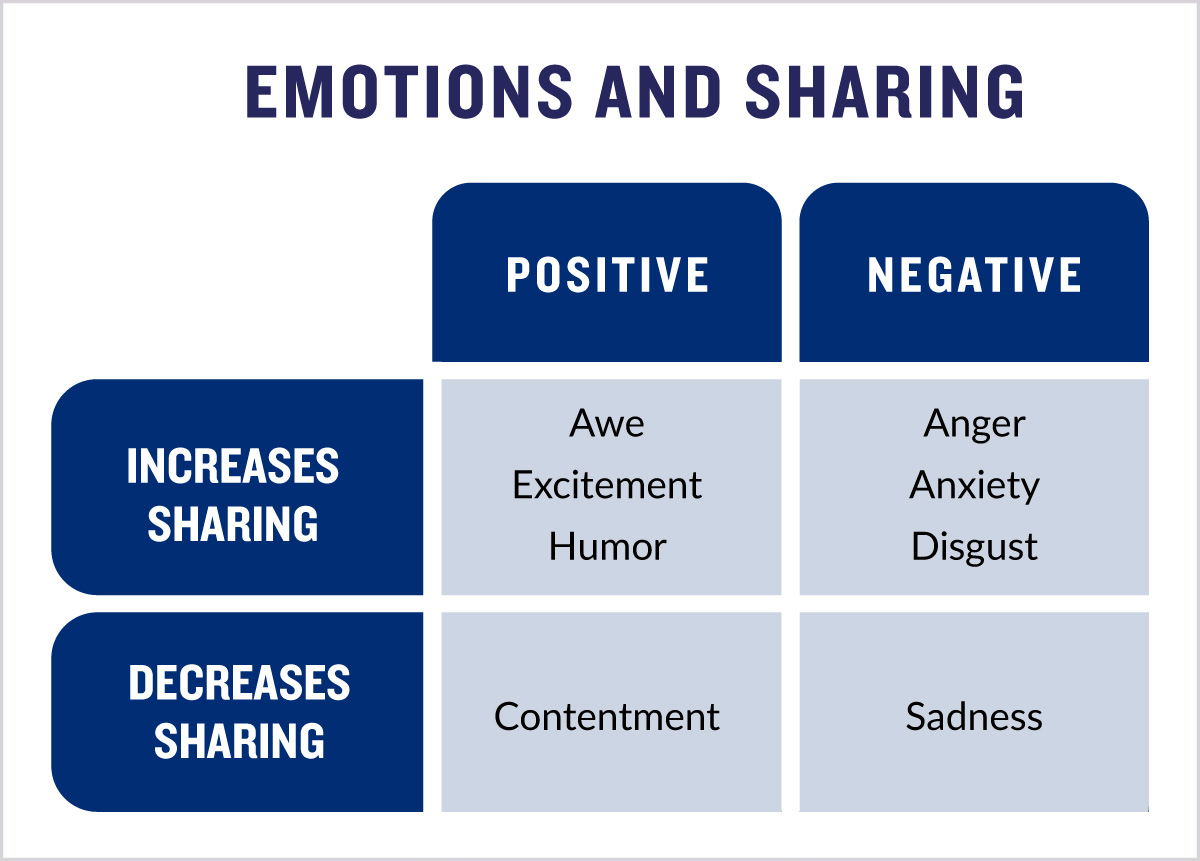In one of the more memorable commercials of Super Bowl 2020, rapper Lil Nas X and actor Sam Elliott face off in a dance duel for Cool Ranch Doritos. With ads for the big game going for a reported $5.6 million for a 30-second spot, was the minute-long video cost-effective for the company? Yes, considering the millions of times the spot was viewed and shared across social media platforms for free.
Shared content is a goldmine for marketers, but it’s tough to determine exactly what moves viewers enough to want to share. A new study from Wharton marketing professor Jonah Berger and Daniel McDuff of Microsoft Research looks at the emotional triggers — happiness, sadness, and even disgust — that make people want to share advertising content.
The study is the largest of its kind and the first to investigate the link between emotional responses to video ads and sharing. It’s also unique in its approach: Thousands of participants in five countries were asked to watch a random set of commercials on their home computers while their webcams recorded their facial expressions. Algorithms built specifically for the task coded their emotional responses. The researchers found that positive emotions resulted in more sharing, but so did feelings of disgust.
Berger answered some questions for Knowledge at Wharton about the study, “Why Do Some Advertisements Get Shared More Than Others,” which was recently published in the Journal of Advertising Research. His responses appear below.
Knowledge at Wharton: The idea of quantifying emotional response is intriguing, especially when you think about high-profile advertisements like the ones aired during the Super Bowl. Marketers invest a lot of money in those ads and really want them to be shared. What motivated you to conduct this research?
Jonah Berger: Everyone wants their content to be shared — from companies with their ads to “influencers” with their videos to content marketers with their content. But actually getting consumers to share is harder than most people think.
As I talk about in my book Contagious, word of mouth has become big business. Rather than paying for additional impressions, word of mouth is a cheaper way to get the word out. Shares are free, so the more people that pass your message along, the less you have to spend on advertising. The only question then is, how to get people to share? And that’s what led to the current research.
Knowledge at Wharton: Why study facial expressions as an indicator of emotion? Wouldn’t it be easier and more precise to ask the participants how they feel or ask them to rate their emotional response on a scale of 1 to 10?
Berger: It certainly seems easier to ask people how they feel or have them rate their response on scale. But there’s a problem: Self-reports are often inaccurate. People don’t always have a good sense of what they are feeling, and even if they give you an answer, it’s not always correct. Further, people sometimes bias their responses based on what they think you want to hear. So, facial expressions can be a valuable alternative. Our face often signals how we’re feeling even if we don’t realize it.
Knowledge at Wharton: What are the key findings and implications for marketers?
Berger: You might think that sharing is all about valence, or positivity and negativity. We share things that make us feel good and avoid sharing things that make us feel bad. After all, why would people want to share something with someone else that would make them feel bad? But that’s not the entire story. While ads that made people smile were more likely to be shared, some negative emotions, like sadness or confusion, decreased sharing, while others, like disgust, increased it. Consistent with other research we’ve conducted (PDF), this highlights that rather than just being about feeling good or bad, sharing is also about the physiological arousal associated with different emotions. Emotions that fire us up to take action, like anger and anxiety (and in this case, disgust) boost sharing, while emotions that power us down (like sadness), decrease sharing.

This has a number of important implications for marketers. First, if you want people to share, making them feel good isn’t enough. Feeling content isn’t going to make people share. You have to fire them up. Make them feel excited, inspired, or surprised.
Second, you don’t have to shy away from negative emotions. Because they fire people up, anger, anxiety or even disgust can be leveraged to encourage word of mouth.
Knowledge at Wharton: Your paper touches on the role of culture in expressing emotion and how that can affect the outcomes. Can you talk about that?
“Feeling content isn’t going to make people share. You have to fire them up.” –Jonah Berger
Berger: We also looked at how the results varied by culture. While smiles were strongly related to sharing in the U.S. and U.K., the effect was smaller in China, France, and Germany, or any country that scores lower on individualism. It’s hard to know for sure, but this suggests the importance of understanding what different emotions mean in different countries.
Knowledge at Wharton: In the paper, you mention that increasing sharing doesn’t necessarily lead to increased sales. How can future research address that?
Berger: Some of the emotions that boost sharing might not always boost sales. An ad that shows something gross might boost sharing, but it might reduce the chance people buy the product. The neat thing about the method is that it can be applied more broadly. Rather than ask people to fill out surveys, just watch how they react to ads. Hopefully, it will allow future research to examine a range of interesting questions.
Jonah Berger’s latest book is The Catalyst: How to Change Anyone’s Mind.


